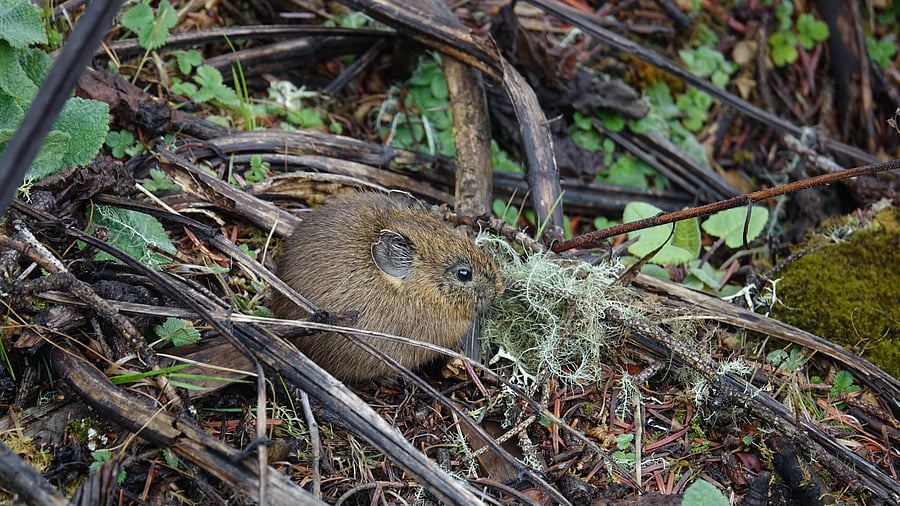
The night at Nyingungla (3,890 m) was bitterly cold, even in spring. Trekking through the ancient Bhutanese trails had always been high on my wish list. We began our second day’s morning ascent toward the Sagala Pass. As we climbed through fir forests and thin mountain air, a sudden rustle caught my eye — a squirrel, I thought, darting across the forest floor. But I was soon proven wrong. Another small creature scurried across the trail and hid under a fallen log. I paused, and after a few moments, two curious eyes and large, rounded ears peeked out.
It wasn’t a squirrel — it was a Moupin pika (pronounced paika), a palm-sized, rufous-grey mammal with a rounded body, short limbs, and no visible tail. I was smitten. As I climbed higher, I began seeing more pikas and countless burrows — proof of how abundant they were at this elevation. Although adorably shy, they were inquisitive enough to peek out of their burrows to inspect the intruder.
Within an hour, we reached the Sagala Pass, which offered fleeting glimpses of the majestic Mount Jomolhari (7,326 m). As we began our descent, the landscape transformed dramatically. The trail dipped into mixed conifers and blooming rhododendrons. Moss blanketed tree trunks and filamentous lichens dangled from the conifers like tattered drapes — giving the forest a Jurassic feel. The change was striking — the tree composition and density appeared significantly greater than on the other side of the pass. The undergrowth shifted, too. Small plants with lilac-coloured flowers with five notched petals and yellow centres standing like tiny floral torches began to appear. These were the hairless primrose (Primula glabra), a charming herbaceous plant common to the Himalayan springtime.
As I admired them, I noticed something else — the pika burrows had almost vanished. There seemed to be more to pikas than met the eye. We had descended roughly 150–200 meters, likely crossing the pika’s thermal comfort zone. With their narrow tolerance for temperature changes and their reliance on cool habitats, I couldn’t help but wonder: where will these delightful animals go if climate change continues to reshape the high-altitude ecosystems they call home? Further down, a fresh splash of yellow caught my eye. Nestled among pine needles were colonies of Bryocarpum himalaicum — a delicate primrose. These bell-shaped flowers hung like mourning lanterns, drooping toward the earth. Each grew from slender stalks ending in broad, wrinkled leaves hugging the base. The species has no English common name, and is the only member of its genus—the species name itself, himalaic, indicates its origin. By now, the hairless primrose had made way to these cousins.
As I strained my eyes for glimpses of the rusty-flanked treecreeper, Mrs Gould’s sunbird, and the Himalayan bluetail, all bustling among the evergreens, the trees around me transformed too. The birch trees with papery bark had emerged, while pines and junipers grew into towering giants. One massive pine had fallen, now decomposing to feed the earth. “How old do you think this tree is?” I asked our guide, Pemba. “Humse bahut zyada booda hogaya,” he replied with a laugh. (It is much older than I am.). It felt literal and metaphorical.
The diversity in herbaceous and vascular plants between this and the previous day’s hike was striking. Was it just elevation and exposure — or were there other, hidden variables at play? Only nature can tell. Every forest, whether nestled in high altitudes or lowland plains, is a web of subtle, layered relationships, and far from homogenous. This three-day trek deepened my belief that the nuances of nature can only be truly understood by moving gently through it — bending our knees to the ground and engaging our most marvellous senses: the eyes, ears and nose. Plants like the Bryocarpum himalaicum are reminders of nature’s quiet elegance. These modest, delicate plants also underscore the need to protect fragile ecosystems where such species thrive — places where even the smallest bloom plays a part in the ecosystem’s grand tapestry.
The writer is a conservation biologist and has authored many books.